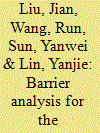|
|
|
Sort Order |
|
|
|
Items / Page
|
|
|
|
|
|
|
| Srl | Item |
| 1 |
ID:
124240


|
|
|
|
|
| Publication |
2013.
|
| Summary/Abstract |
Distributed energy (DE) is receiving lots of attention from the Chinese government. A number of DE projects have been constructed in China. However, there are still numerous problems with DE projects. What hinders the development of DE in China? The Huadian Jimei distributed energy project (HJDE) is a typical DE building project that was not completed successfully. This paper focuses on this DE project to explore the barriers to DE development. The research group conducted 13 semi-structured interviews with representatives of institutions and corporations involved in the HJDE project to collect information. Based on the information, three types of problems were determined, and the results indicate that these conflicts between the core stakeholders make DE projects unsuccessful. These problems result from institutional barriers to DE, rooting in the development policy and the current energy market. Moreover, several key stakeholders are not able to play an active role in the design or management of DE projects. The Chinese government will put a much greater effort into the development of future DE projects. Many national support policies and rules will be announced, which are easy to practical use. Under these conditions, 1000 DE projects will be successfully completed until 2015.
|
|
|
|
|
|
|
|
|
|
|
|
|
|
|
|
| 2 |
ID:
119836


|
|
|
|
|
| Publication |
2013.
|
| Summary/Abstract |
Sustainability research at the city scale is increasingly focusing on urban household consumption in the context of global climate change. We use a complementary emergy accounting (EMA) and carbon footprint accounting (CFA) method to investigate the environmental pressure generated by household consumption in Xiamen, China. We distinguish between the resource extraction, consumption and disposal stages within an urban spatial conceptual framework, comprising the Urban Footprint Region (UFR) and Urban Sprawl Region (USR), and analyze five environmental footprint categories associated with cross-boundary household emergy and carbon flows. Cross-boundary activities, which link the USR with its UFR, contributed nearly 90% of total emergy and 70% of total GHG emissions in CFA. Transport fuel, building materials and food contribute most to environmental pressure in both EMA and CFA. The results indicate a significant cross-boundary resource burden and environmental footprint associated with household activities. The employed framework, method, and scope challenge the conventional spatial boundary of the urban system, and the results have important policy implications for urban sustainability and cross-boundary environmental management.
|
|
|
|
|
|
|
|
|
|
|
|
|
|
|
|
|
|
|
|
|